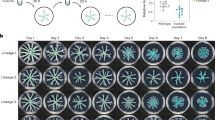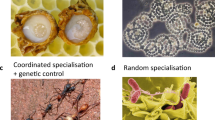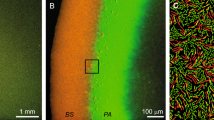Abstract
Cooperation among individuals is necessary for evolutionary transitions to higher levels of biological organization1,2,3. In such transitions, groups of individuals at one level (such as single cells) cooperate to form selective units at a higher level (such as multicellular organisms). Though the evolution of cooperation is difficult to observe directly in higher eukaryotes, microorganisms do offer such an opportunity4. Here we report the evolution of novel cooperative behaviour in experimental lineages of the bacterium Myxococcus xanthus. Wild-type strains of M. xanthus exhibit socially dependent swarming across soft surfaces5 by a mechanism known as ‘S-motility’ that requires the presence of extracellular type IV pili6. In lineages of M. xanthus unable to make pili, a new mechanistic basis for cooperative swarming evolved. Evolved swarming is mediated, at least in part, by enhanced production of an extracellular fibril matrix that binds cells—and their evolutionary interests—together. Though costly to individuals, fibril production greatly enhanced population expansion in groups of interconnected cells. These results show that fundamental transitions to primitive cooperation can readily occur in bacteria.
This is a preview of subscription content, access via your institution
Access options
Subscribe to this journal
Receive 51 print issues and online access
$199.00 per year
only $3.90 per issue
Buy this article
- Purchase on Springer Link
- Instant access to full article PDF
Prices may be subject to local taxes which are calculated during checkout




Similar content being viewed by others
References
Buss, L. W. The Evolution of Individuality (Princeton Univ. Press, Princeton, NJ, 1987)
Maynard Smith, J. & Szathmáry, E. The Major Transitions in Evolution (W.H. Freeman Spektrum, Oxford/New York, 1995)
Michod, R. E. & Roze, D. Cooperation and conflict in the evolution of multicellularity. Heredity 86, 1–7 (2001)
Crespi, B. J. The evolution of social behavior in microorganisms. Trends Ecol. Evol. 16, 178–183 (2001)
Shi, W. & Zusman, D. R. The two motility systems of Myxococcus xanthus show different selective advantages on various surfaces. Proc. Natl Acad. Sci. USA 90, 3378–3382 (1993)
Wu, S. S. & Kaiser, D. Genetic and functional evidence that Type IV pili are required for social gliding motility in Myxococcus xanthus. Mol. Microbiol. 18, 547–558 (1995)
Velicer, G. J., Lenski, R. E. & Kroos, L. Rescue of social motility lost during evolution of Myxococcus xanthus in an asocial environment. J. Bacteriol. 184, 2719–2727 (2002)
Pfeiffer, T. & Bonhoeffer, S. An evolutionary scenario for the transition to undifferentiated multicellularity. Proc. Natl Acad. Sci. USA 100, 1095–1098 (2003)
Rainey, P. B. & Rainey, K. Evolution of cooperation and conflict in experimental bacterial populations. Nature 425, 72–74 (2003)
Velicer, G. J. Social strife in the microbial world. Trends Microbiol 11, 330–337 (2003)
Velicer, G. J., Kroos, L. & Lenski, R. E. Loss of social behaviors by Myxococcus xanthus during evolution in an unstructured habitat. Proc. Natl Acad. Sci. USA 95, 12376–12380 (1998)
Shimkets, L. J. Intercellular signaling during fruiting-body development of Myxococcus xanthus. Annu. Rev. Microbiol. 53, 525–549 (1999)
Hodgkin, J. & Kaiser, D. Genetics of gliding motility in Myxococcus xanthus (Myxobacterales): two gene systems control movement. Mol. Gen. Genet. 171, 177–191 (1979)
Behmlander, R. M. & Dworkin, M. Biochemical and structural analyses of the extracellular matrix fibrils of Myxococcus xanthus. J. Bacteriol. 176, 6295–6303 (1994)
Kearns, D. B., Campbell, B. D. & Shimkets, L. J. Myxococcus xanthus fibril appendages are essential for excitation by a phospholipid attractant. Proc. Natl Acad. Sci. USA 97, 11505–11510 (2000)
Li, Y. et al. Extracellular polysaccharides mediate pilus retraction during social motility of Myxococcus xanthus. Proc. Natl Acad. Sci. USA 100, 5443–5448 (2003)
Wolgemuth, C., Hoiczyk, E., Kaiser, D. & Oster, G. How myxobacteria glide. Curr. Biol. 12, 369–377 (2002)
Dana, J. R. & Shimkets, L. J. Regulation of cohesion-dependent cell interactions in Myxococcus xanthus. J. Bacteriol. 175, 3636–3647 (1993)
Rodriguez, A. M. & Spormann, A. M. Genetic and molecular analysis of cglB, a gene essential for single-cell gliding in Myxococcus xanthus. J. Bacteriol. 181, 4381–4390 (1999)
Shimkets, L. J. Role of cell cohesion in Myxococcus xanthus fruiting body formation. J. Bacteriol. 166, 842–848 (1986)
Kearns, D. B. & Shimkets, L. J. Lipid chemotaxis and signal transduction in Myxococcus xanthus. Trends Microbiol. 9, 126–129 (2001)
Lancero, H. et al. Mapping of Myxococcus xanthus social motility dsp mutations to the dif genes. J. Bacteriol. 184, 1462–1465 (2002)
Arnold, J. W. & Shimkets, L. J. Inhibition of cell-cell interactions in Myxococcus xanthus by Congo Red. J. Bacteriol. 170, 5765–5770 (1988)
Kearns, D. B., Bonner, P. J., Smith, D. R. & Shimkets, L. J. An extracellular matrix-associated zinc metalloprotease is required for dilauroyl phosphatidylethanolamine chemotactic excitation in Myxococcus xanthus. J. Bacteriol. 184, 1678–1684 (2002)
Behmlander, R. M. & Dworkin, M. Extracellular fibrils and contact-mediated cell interactions in Myxococcus xanthus. J. Bacteriol. 173, 7810–7821 (1991)
Queller, D. C., Ponte, E., Bozzaro, S. & Strassmann, J. E. Single-gene greenbeard effects in the social amoeba Dictyostelium discoideum. Science 299, 105–106 (2003)
Cramton, S. E., Ulrich, M., Götz, F. & Doring, G. Anaerobic conditions induce expression of polysaccharide intercellular adhesin in Staphylococcus aureus and Staphylococcus epidermidis. Infect. Immun. 69, 4079–4085 (2001)
Krause, J. & Ruxton, G. D. Living in Groups (Oxford Univ. Press, Oxford/New York, 2002)
Wu, S. S. & Kaiser, D. Markerless deletions of pil genes in Myxococcus xanthus generated by counterselection with the Bacillus subtilis sacB gene. J. Bacteriol. 178, 5817–5821 (1996)
Wu, S. S. & Kaiser, D. Regulation of expression of the pilA gene in Myxococcus xanthus. J. Bacteriol. 179, 7748–7758 (1997)
Acknowledgements
We are grateful to S. Bonhoeffer, S. Elena, L. Kroos, P. Rainey and W. Shi for discussion or comments, I. Dinkelacker and F. Fiegna for technical assistance, K. Hillesland for construction of strains A1 and A2, D. Kaiser and H. Kaplan for antibodies and plasmids, L. Shimkets for discussion and strains, and J. Berger and H. Schwarz for electron microscopy expertise and assistance.
Author information
Authors and Affiliations
Corresponding author
Ethics declarations
Competing interests
The authors declare that they have no competing financial interests.
Rights and permissions
About this article
Cite this article
Velicer, G., Yu, Yt. Evolution of novel cooperative swarming in the bacterium Myxococcus xanthus. Nature 425, 75–78 (2003). https://doi.org/10.1038/nature01908
Received:
Accepted:
Issue Date:
DOI: https://doi.org/10.1038/nature01908
This article is cited by
-
Adaptation to novel spatially-structured environments is driven by the capsule and alters virulence-associated traits
Nature Communications (2022)
-
Hidden paths to endless forms most wonderful: ecology latently shapes evolution of multicellular development in predatory bacteria
Communications Biology (2022)
-
Hidden paths to endless forms most wonderful: Complexity of bacterial motility shapes diversification of latent phenotypes
BMC Evolutionary Biology (2020)
-
Microbial life cycles link global modularity in regulation to mosaic evolution
Nature Ecology & Evolution (2019)
-
Multicellular Individuality: The Case of Bacteria
Biological Theory (2019)
Comments
By submitting a comment you agree to abide by our Terms and Community Guidelines. If you find something abusive or that does not comply with our terms or guidelines please flag it as inappropriate.



